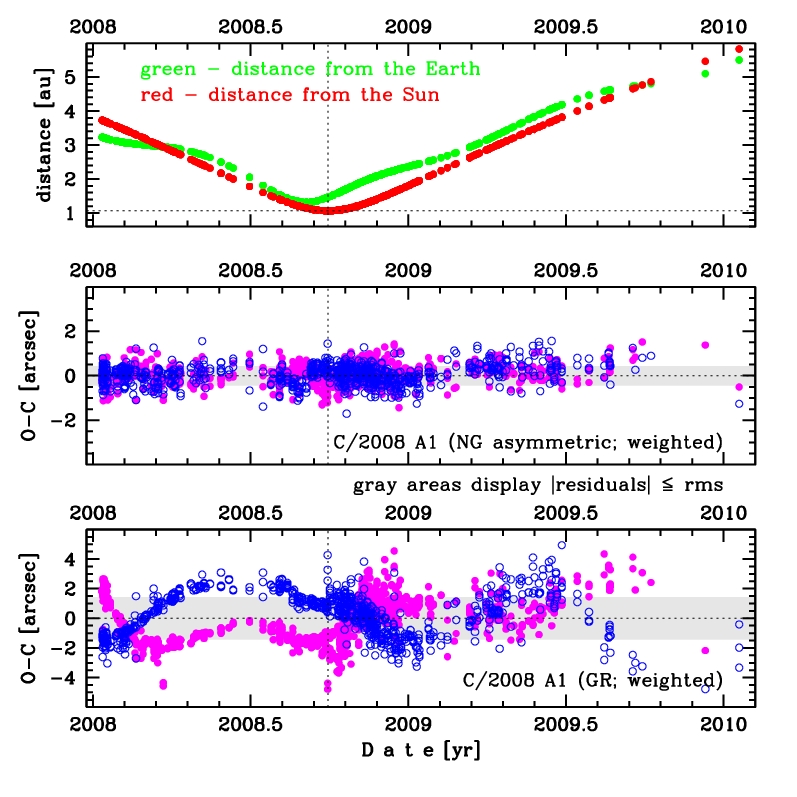| Solar System Dynamics & Planetology Group |
 |
C/2008 A1 McNaught |  |
| Solar System Dynamics & Planetology Group |
 |
C/2008 A1 McNaught |  |

| number of observations | 937 |
| number of residuals | 1852 |
| data interval | 2008 Jan. 10 — 2010 Jan. 17 |
| rms [arcsec] | 0.44 |
| orbit quality class | 1a |
| Epoch (TT) | 20080911.0 | = JD 2454720.5 |
| time of perihelion passage (TT) | 20080929.127602 | ± 0.000067 |
| perihelion distance | 1.07306392 | ± 0.00000067 |
| eccentricity | 1.00018943 | ± 0.00000225 |
| argument of perihelion[deg] | 348.477291 | ± 0.000083 |
| longitude of the ascending node [deg] | 277.883733 | ± 0.000026 |
| inclination[deg] | 82.549129 | ± 0.000012 |
| inverse semimajor axis [10-6 au-1] | -176.53 | ± 2.10 |
| Nongravitational parameters [10-8 au/day2] | A1 = 5.5964 ± 0.0570 | A2 = 0.7136 ± 0.0384 | A3 = 0.16800 ± 0.00815 |
| time shift of g(r) relative to perihelion [day] | 5.76 ± 0.6 |
| Epoch (TT) | 17090122.0 | |
| time of perihelion passage (TT) | 20080929.788657 | ± 0.000061 |
| perihelion distance | 1.07272957 | ± 0.00000096 |
| eccentricity | 0.99986798 | ± 0.00000161 |
| argument of perihelion[deg] | 348.519718 | ± 0.000054 |
| longitude of the ascending node [deg] | 277.853954 | ± 0.000024 |
| inclination[deg] | 82.555262 | ± 0.000013 |
| inverse semimajor axis [10-6 au-1] | 123.07 | ± 1.50 |
| Epoch (TT) | 23091223.0 | |
| time of perihelion passage (TT) | 20080929.205406 | ± 0.000085 |
| perihelion distance | 1.06958685 | ± 0.00000305 |
| eccentricity | 0.99972575 | ± 0.00000239 |
| argument of perihelion[deg] | 348.352122 | ± 0.000179 |
| longitude of the ascending node [deg] | 277.900996 | ± 0.000025 |
| inclination[deg] | 82.577603 | ± 0.000017 |
| inverse semimajor axis [10-6 au-1] | 256.41 | ± 2.24 |
| number of observations | 393 |
| number of residuals | 770 |
| data interval | 2008 Jan. 10 — 2008 Sep. 28 (pre-perihelion data) |
| rms [arcsec] | 0.28 |
| orbit quality class | 1b |
| Epoch (TT) | 20080911.0 | = JD 2454720.5 |
| time of perihelion passage (TT) | 20080929.125802 | ± 0.000332 |
| perihelion distance | 1.07308711 | ± 0.00000375 |
| eccentricity | 1.00026451 | ± 0.00001289 |
| argument of perihelion[deg] | 348.474897 | ± 0.000437 |
| longitude of the ascending node [deg] | 277.882018 | ± 0.000212 |
| inclination[deg] | 82.550006 | ± 0.000100 |
| inverse semimajor axis [10-6 au-1] | -246.50 | ± 12.01 |
| Nongravitational parameters [10-8 au/day2] | A1 = 4.608 ± 0.136 | A2 = 1.894 ± 0.233 | A3 = 1.844 ± 0.203 |
| Epoch (TT) | 17090122.0 | |
| time of perihelion passage (TT) | 20080929.789350 | ± 0.000230 |
| perihelion distance | 1.07273156 | ± 0.00000106 |
| eccentricity | 0.99987037 | ± 0.00000218 |
| argument of perihelion[deg] | 348.519683 | ± 0.000072 |
| longitude of the ascending node [deg] | 277.854140 | ± 0.000024 |
| inclination[deg] | 82.555436 | ± 0.000021 |
| inverse semimajor axis [10-6 au-1] | 120.84 | ± 2.03 |
| number of observations | 544 |
| number of residuals | 1072 |
| data interval | 2008 Oct. 1 — 2010 Jan. 17 (post-perihelion data) |
| rms [arcsec] | 0.54 |
| orbit quality class | 1b |
| Epoch (TT) | 20080911.0 | = JD 2454720.5 |
| time of perihelion passage (TT) | 20080929.124280 | ± 0.000432 |
| perihelion distance | 1.07294448 | ± 0.00000714 |
| eccentricity | 0.99955656 | ± 0.00003447 |
| argument of perihelion[deg] | 348.472703 | ± 0.000583 |
| longitude of the ascending node [deg] | 277.886946 | ± 0.000197 |
| inclination[deg] | 82.556261 | ± 0.000473 |
| inverse semimajor axis [10-6 au-1] | 413.30 | ± 32.12 |
| Nongravitational parameters [10-8 au/day2] | A1 = 10.094 ± 0.282 | A2 = 6.142 ± 0.291 | A3 = -4.431 ± 0.306 |
| Epoch (TT) | 23091113.0 | |
| time of perihelion passage (TT) | 20080929.208570 | ± 0.000181 |
| perihelion distance | 1.06952611 | ± 0.00000546 |
| eccentricity | 0.99973634 | ± 0.00000302 |
| argument of perihelion[deg] | 348.350303 | ± 0.000270 |
| longitude of the ascending node [deg] | 277.900870 | ± 0.000048 |
| inclination[deg] | 82.577708 | ± 0.000016 |
| inverse semimajor axis [10-6 au-1] | 246.52 | ± 2.82 |